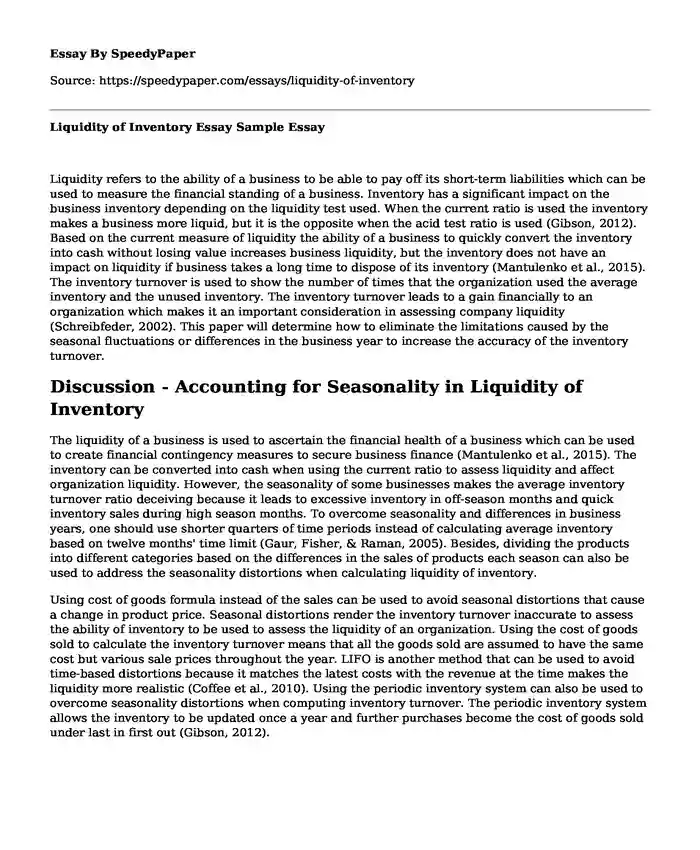
| Type of paper: | Essay |
| Categories: | Accounting Financial management |
| Pages: | 3 |
| Wordcount: | 684 words |
Liquidity refers to the ability of a business to be able to pay off its short-term liabilities which can be used to measure the financial standing of a business. Inventory has a significant impact on the business inventory depending on the liquidity test used. When the current ratio is used the inventory makes a business more liquid, but it is the opposite when the acid test ratio is used (Gibson, 2012). Based on the current measure of liquidity the ability of a business to quickly convert the inventory into cash without losing value increases business liquidity, but the inventory does not have an impact on liquidity if business takes a long time to dispose of its inventory (Mantulenko et al., 2015). The inventory turnover is used to show the number of times that the organization used the average inventory and the unused inventory. The inventory turnover leads to a gain financially to an organization which makes it an important consideration in assessing company liquidity (Schreibfeder, 2002). This paper will determine how to eliminate the limitations caused by the seasonal fluctuations or differences in the business year to increase the accuracy of the inventory turnover.
Discussion - Accounting for Seasonality in Liquidity of Inventory
The liquidity of a business is used to ascertain the financial health of a business which can be used to create financial contingency measures to secure business finance (Mantulenko et al., 2015). The inventory can be converted into cash when using the current ratio to assess liquidity and affect organization liquidity. However, the seasonality of some businesses makes the average inventory turnover ratio deceiving because it leads to excessive inventory in off-season months and quick inventory sales during high season months. To overcome seasonality and differences in business years, one should use shorter quarters of time periods instead of calculating average inventory based on twelve months' time limit (Gaur, Fisher, & Raman, 2005). Besides, dividing the products into different categories based on the differences in the sales of products each season can also be used to address the seasonality distortions when calculating liquidity of inventory.
Using cost of goods formula instead of the sales can be used to avoid seasonal distortions that cause a change in product price. Seasonal distortions render the inventory turnover inaccurate to assess the ability of inventory to be used to assess the liquidity of an organization. Using the cost of goods sold to calculate the inventory turnover means that all the goods sold are assumed to have the same cost but various sale prices throughout the year. LIFO is another method that can be used to avoid time-based distortions because it matches the latest costs with the revenue at the time makes the liquidity more realistic (Coffee et al., 2010). Using the periodic inventory system can also be used to overcome seasonality distortions when computing inventory turnover. The periodic inventory system allows the inventory to be updated once a year and further purchases become the cost of goods sold under last in first out (Gibson, 2012).
Conclusion
Due to the seasonal fluctuations in some businesses when counting the inventory turnover using the beginning of the year and the end year inventories can be misleading. Using periodic or monthly inventory balances to estimate the inventory can be used to resolve the seasonal and business year definition distortions. Monthly and quarterly inventory figures should be used in calculating inventory turnover to avoid the overstatement or understatement of the inventory turnover which could lead to a misleading assumption of the organization liquidity of inventory.
References
Coffee, D., Roig, R., Lirely, R., & Little, P. (2010). The materiality of LIFO accounting distortions on liquidity measurements. Journal of Finance and Accountancy, 2, 1.
Gaur, V., Fisher, M. L., & Raman, A. (2005). An econometric analysis of inventory turnover performance in retail services. Management Science, 51(2), 181-194.
Gibson, Charles H. (2012). Financial Reporting and Analysis + Thomsonone Printed Access Card. South-Western Pub.
Mantulenko, V., Smolina, E., Zotova, A., & Vishnyakova, A. (2015). The Relation of Inventories Turnover and Liquidity Indicators in the Trade and Services Organizations in the Context of the Solvency Assessment.
Schreibfeder, J. (2002). The First Steps to Achieving Effective Inventory Control. Microsoft Business Solution.
Cite this page
Liquidity of Inventory Essay Sample. (2022, Jul 27). Retrieved from https://speedypaper.com/essays/liquidity-of-inventory
Request Removal
If you are the original author of this essay and no longer wish to have it published on the SpeedyPaper website, please click below to request its removal:
- Free Essay Sample on Protective Role of Blood Groups
- Free Essay Example on Customer Satisfaction
- Free Essay with Tobacco Industry Environmental Analysis
- The Molarity of Abortion by Mark T. Brown, Free Essay
- Dissertation Abstract Example: How, When and Why Kuwait Come to Be a British Protectorate?
- Essay Example Dedicated to Aldous Huxley's Political Affiliations
- Biography of Tom Hanks
Popular categories




